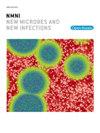Antibiotic resistance patterns of community-acquired urinary tract infections caused by Enterobacterales in Albania
IF 5.4
Q2 INFECTIOUS DISEASES
引用次数: 0
Abstract
Background
The escalating rates of antibiotic resistance, especially through Extended-Spectrum Beta-Lactamase (ESBL) production within Enterobacterales represents a critical challenge in the effective management and treatment of urinary tract infections (UTIs). This study aims to examine the distribution of pathogens, assess the prevalence of ESBL production, and analyze the resistance patterns of Enterobacterales isolated from outpatient urocultures in Albania.
Methods
Midstream urine specimens from 406 patients were cultured on MacConkey agar and analyzed using the VITEK 2 automated system (bioMérieux, France). Samples with a bacterial count of ≥100,000 CFU/ml were considered positive for UTIs. Statistical analyses were conducted using SPSS software, version 27.0.
Results
Among the analyzed samples, 271 (66.7 %) tested positive for UTIs. Gram-negative bacteria, particularly Enterobacterales (88.5 %) were the most common while E. coli was the predominant microorganism (87.0 %). The demographic analysis revealed that females (74.5 %) and young adults (18–34 years) (54.0 %) were the most affected groups. High resistance rates were observed for tetracycline (55.0 %), piperacillin (43.0 %), and trimethoprim (38.5 %), while resistance to meropenem was very low (1.0 %). A total of 25 isolates (12.5 %) were positive for ESBL production. Among the E. coli isolates, 12.1 % (21/174) tested positive. Statistical analysis indicated a significant association between female gender and increased antibiotic resistance.
Conclusions
Our findings highlight the significant issue of antibiotic resistance in community-acquired UTIs in Albania, particularly involving Enterobacterales. Ongoing surveillance and tailored treatment strategies, alongside antibiotic stewardship programs, are crucial to address this growing public health concern.
阿尔巴尼亚肠杆菌引起的社区获得性尿路感染的抗生素耐药模式
随着抗生素耐药性的不断上升,尤其是肠杆菌中广谱β -内酰胺酶(ESBL)的产生,对尿路感染(uti)的有效管理和治疗提出了严峻的挑战。本研究旨在检查病原体的分布,评估ESBL生产的流行程度,并分析阿尔巴尼亚门诊泌尿培养中分离的肠杆菌的耐药模式。方法406例患者的中程尿液标本在MacConkey琼脂上培养,使用VITEK 2自动系统(biomacrieux, France)进行分析。细菌计数≥100,000 CFU/ml的样品被认为是uti阳性。采用SPSS软件27.0进行统计分析。结果271例(66.7%)尿路感染阳性。革兰氏阴性菌以肠杆菌为主(88.5%),大肠杆菌为优势菌(87.0%)。人口统计学分析显示,女性(74.5%)和青壮年(18-34岁)(54.0%)是受影响最大的群体。对四环素(55.0%)、哌拉西林(43.0%)、甲氧苄啶(38.5%)的耐药率较高,对美罗培南的耐药率极低(1.0%)。共有25株(12.5%)ESBL产生阳性。在分离的大肠杆菌中,12.1%(21/174)呈阳性。统计分析表明,女性与抗生素耐药性增加之间存在显著关联。结论我们的研究结果突出了阿尔巴尼亚社区获得性尿路感染中抗生素耐药性的重要问题,特别是肠杆菌。持续的监测和量身定制的治疗策略,以及抗生素管理项目,对于解决这一日益严重的公共卫生问题至关重要。
本文章由计算机程序翻译,如有差异,请以英文原文为准。
求助全文
约1分钟内获得全文
求助全文
来源期刊

New Microbes and New Infections
Medicine-Infectious Diseases
CiteScore
10.00
自引率
2.50%
发文量
91
审稿时长
114 days
 求助内容:
求助内容: 应助结果提醒方式:
应助结果提醒方式:


